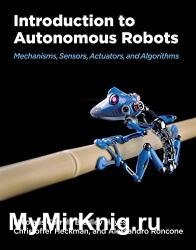 Название: Introduction to Autonomous Robots: Mechanisms, Sensors, Actuators, and Algorithms Название: Introduction to Autonomous Robots: Mechanisms, Sensors, Actuators, and Algorithms
Автор: Nikolaus Correll, Bradley Hayes, Christoffer Heckman, Alessandro Roncone
Издательство: The MIT Press
Год: 2022
Страниц: 268
Язык: английский
Формат: epub (true)
Размер: 13.8 MB
A comprehensive introduction to the field of autonomous robotics aimed at upper-level undergraduates and offering additional online resources.
Textbooks that provide a broad algorithmic perspective on the mechanics and dynamics of robots almost unfailingly serve students at the graduate level. Introduction to Autonomous Robots offers a much-needed resource for teaching third- and fourth-year undergraduates the computational fundamentals behind the design and control of autonomous robots. The authors use a class-tested and accessible approach to present progressive, step-by-step development concepts, alongside a wide range of real-world examples and fundamental concepts in mechanisms, sensing and actuation, computation, and uncertainty. Throughout, the authors balance the impact of hardware (mechanism, sensor, actuator) and software (algorithms) in teaching robot autonomy.
Artificial neural networks (ANNs) are part of a class of machine learning techniques that are loosely inspired by neural operation in the human brain; in robotics, they are generally used to classify or regress data for the dual purposes of perception (e.g., chapters 8 and 9) and control (e.g., as covered in chapter 11). While ANNs for the longest time have been just one of the many methods available to roboticists from the neighboring field of Machine Learning, recent advances in computing—in particular, graphical processing units (GPU)—and the availability of large datasets have enabled the training of neural networks with many layers, commonly referred to as Deep Learning. These (often massive) networks have led to revolutionary results in many fields including computer vision, natural language processing (NLP), video and speech processing, and robotics. Not too long ago, neural networks were considered “deep” if they had just more than two layers. Today, “deep” neural networks can have hundreds of layers and thousands of inputs and outputs—if not more.
Features:
Rigorous and tested in the classroom
Written for engineering and computer science undergraduates with a sophomore-level understanding of linear algebra, probability theory, trigonometry, and statistics
QR codes in the text guide readers to online lecture videos and animations
Topics include: basic concepts in robotic mechanisms like locomotion and grasping, plus the resulting forces; operation principles of sensors and actuators; basic algorithms for vision and feature detection; an introduction to artificial neural networks, including convolutional and recurrent variants
Extensive appendices focus on project-based curricula, pertinent areas of mathematics, backpropagation, writing a research paper, and other topics
A growing library of exercises in an open-source, platform-independent simulation (Webots)
Скачать Introduction to Autonomous Robots: Mechanisms, Sensors, Actuators, and Algorithms
|